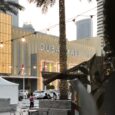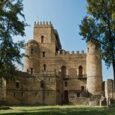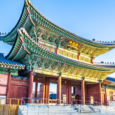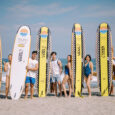Day 3: Summit and Descend
SEE GALLERY BELOW FOR PICTURES.
The Trail Adventours team was among the first to wake at 0100H, as we are scheduled for a 1430H summit push. Light breakfast and final preparations were in order, as well as a quick meeting from our team leaders. The temperature outside the hut was hovering between a “warm” 9-10C.
Big packs were left behind the dormitories, and we proceeded with just small daypacks, water, snacks, and our weatherproof layers. (My summit kit is shared later in the article.)
Mount Kinabalu’s summit route is notorious for being well marked but deadly to the knees and quads, as park authorities have installed staircases of all shapes, sizes, and materials up until the Sayat-Sayat Checkpoint. We went through metal stairs at first, followed by seemingly never-ending wooden stairs and those cut out from the rock. At above 3,500 meters above sea level, the thin air and the hard hike from the day before was taking its toll on many hikers.
We also navigated slippery roped segments, and I was thankful for some experience with rock climbing and rope work – they certainly help! The right shoes also contribute to the comfort and safety of the hike up to the summit, as the terrain was virtually nothing but slippery, damp granite.
All hikers up Mount Kinabalu are required to wear official, named permits at all times. These ID permits were shown to the officials at the aforementioned Sayat-Sayat Checkpoint and once cleared, hikers are permitted to make a summit attempt.
A white rope tethered to the ground marked the “summit path”. In cases of rain or heavy clouds, this rope is the only thing keeping hikers on a safe trail. It can also be grabbed onto when the wind turns for the worse.
The famed summit plateau is not exactly flat; it steadily rises at a shallow incline, but is tilted to one side. It’s one of the toughest things on one’s leg muscles especially with the wind and the cold. It was about 2C at the plateau right before dawn broke, so yes, it was not exactly a walk in the park.
The sun broke right as we reached Low’s Gully, a deep crack in the earth (or should I say, granite) that seemingly never ends. No one was there but our team; it is not part of the ‘white rope trail’ but since we were all experienced hikers and we had our local guide with us, we trekked a bit to the side and saw sunrise that brought me quite close to tears.
From Low’s Gully, it was a simple and straightforward half an hour to make the summit, a rocky scramble up to the top of the new summit marker. The summit itself is tiny, with space barely able to hold a clutch of people. At 4,096 meters above sea level, we were finally at “the highest point between the Himalaya and Guinea” and at that moment possibly the highest Filipinos in Southeast Asia!
We then spent the next 7-8 hours descending the entire mountain, up to the Park HQ where our adventure began. A two-hour van ride thereafter brought us back to Kota Kinabalu, where we spent the night resting and eating as well as last minute packing. This day was over much too fast, as we knew we would be in Manila the very next day.
Day 4: End of the Adventure
Our team leaders awarded us our official Mount Kinabalu certificates and shirts, and after a light breakfast we all headed off to Kota Kinabalu International Airport for our flight back home.
Mount Kinabalu is a must-have peak in a Filipino adventure hiker’s mountain/trail list, and a great way to experience how other countries do nature trails. It was well preserved, revered, and incredibly organized, an experience we would not soon forget.
My adventure gear, packing list (total minus trekking clothes, boots, food, and water: 6.1kg)
- Passport
- Travel Insurance with Emergency Rescue copies
- Lowe Alpine Eclipse 45/55
- Deuter dry sack (15L)
- Eagle Creek clean/dirty clothes bag
- Cotton shirt (x1)
- Berghaus technical shirt (x2)
- Salomon hiking shorts (x1)
- Underwear (x4)
- Smartwool hiking socks (x2)
- Power bank (x2)
- Titan Loop and GoPro charging cables
- Torchlight (x1)
- Food container and spork (x1)
- Empty 500ml water bottles (4x)
- Multipurpose knife (x1)
- Trail bar (x6)
- Nescafe 3-in-1 coffee (x4)
- 50g peanut packs (x4)
- Basic first aid kit with medicines (x1)
- Personal toiletries bag (x1)
- Slippers (x1)
- TNF Dryvent hat (x1)
- Waterproof phone dry bag (x1)
- Spare AAA batteries (x3)
- Plastic bags (x3)
Summit gear:
- Beanie
- Salomon buff
- Ozark Trail headlamp
- UnderArmour Alter Ego base layer
- Pinoy Fitness technical shirt
- TNF fleece jacket
- Berghaus weatherproof hardshell jacket
- Columbia Omniheat gloves
- Thermal underwear
- Core Industries hiking pants
- Smartwool hiking socks
- Salomon X-ALP Pro boots.
Mt. Kinabalu has a difficulty rating of 6/9, but the altitude is what makes the hike extra challenging. I personally recommend a hiker to experience several 5-6/9 local hikes before attempting Kinabalu, and also to summit Mount Apo first as a patriotic thing to do.
Get in touch with Trail Adventours and book your first high altitude hike with them at Mount Kinabalu!
All photos by me unless stated otherwise.
License – CC: Attribution, non-commercial.
The Hike Up Malaysia’s Highest – A Full Commentary of a Mount Kinabalu Adventure
Transparency disclaimer:
- Partial adventure sponsor: Trail Adventours.
- Partial gear sponsors: Berghaus, Pinoy Fitness, and Salomon Pilipinas.




